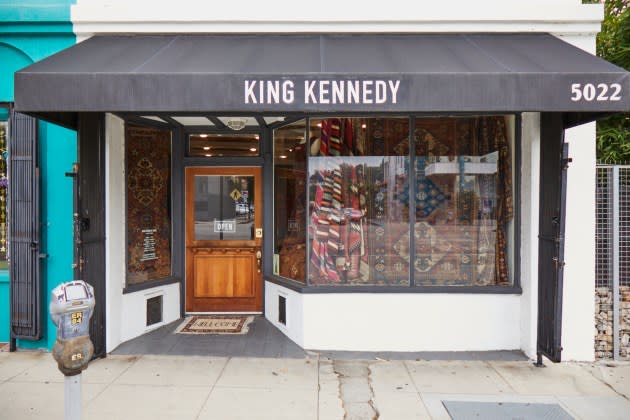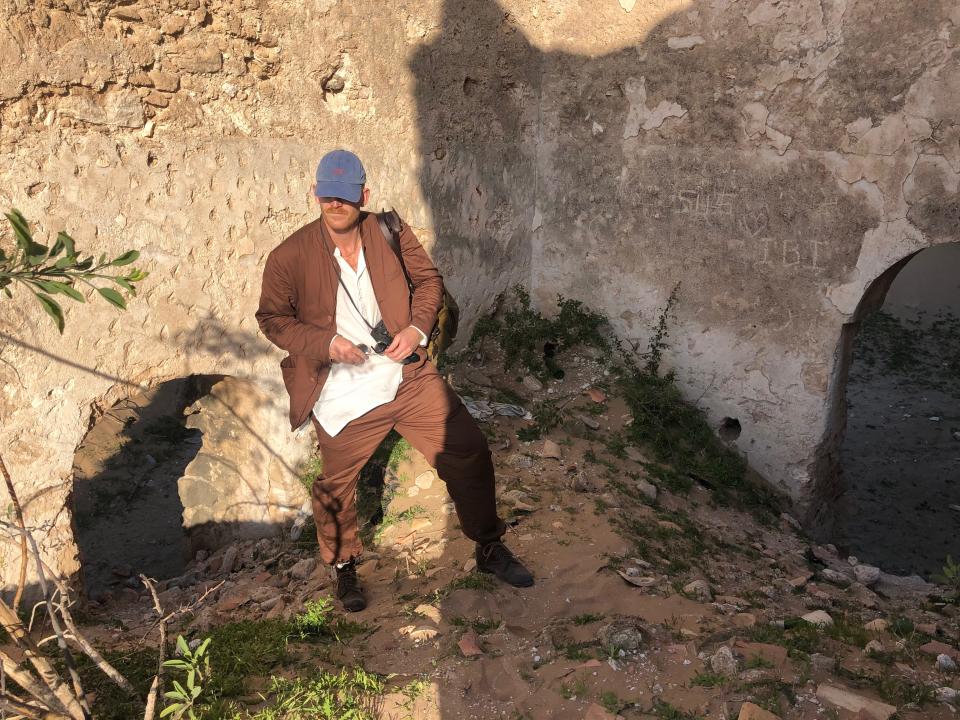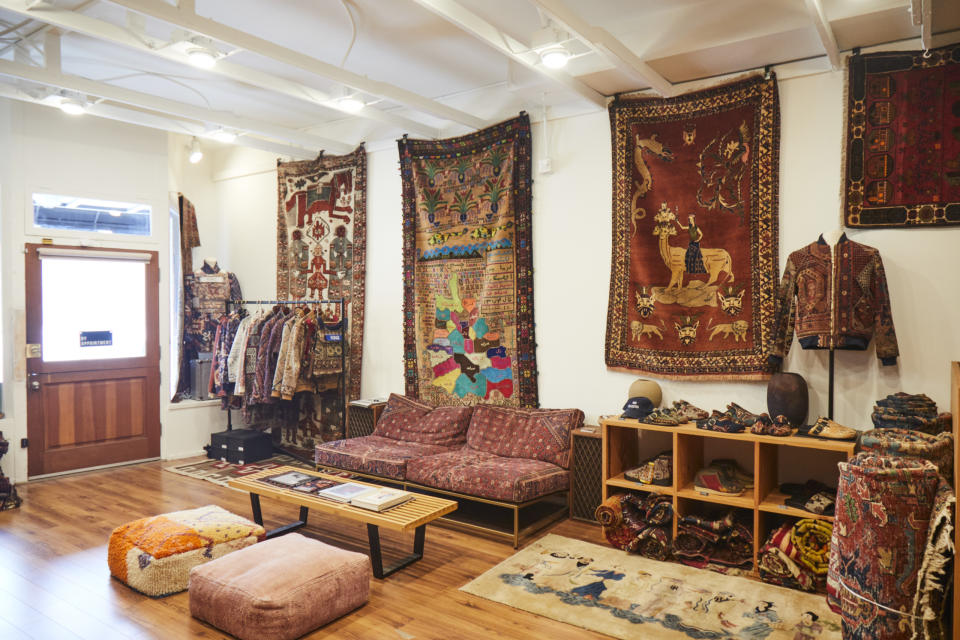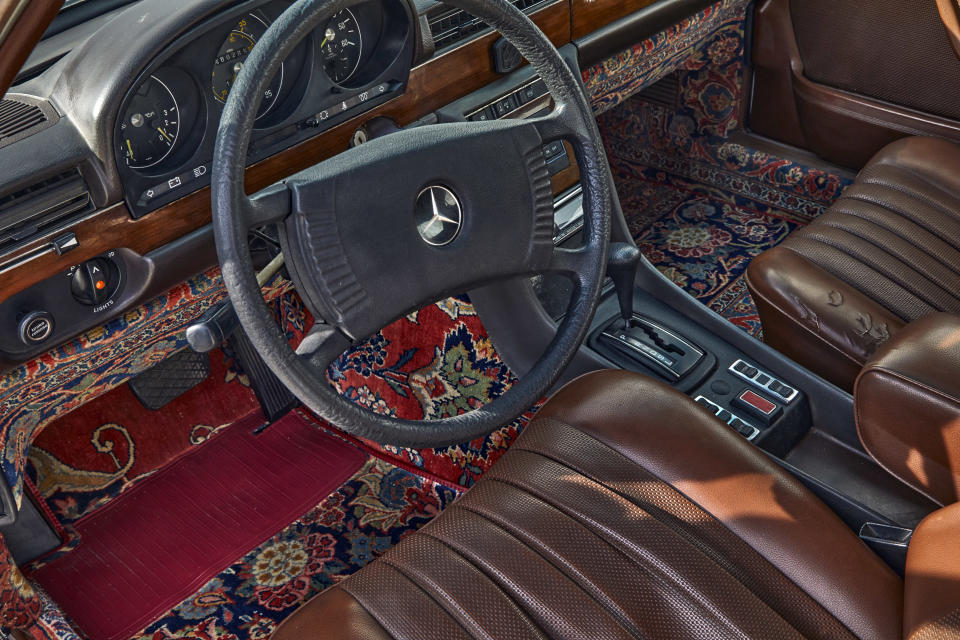EXCLUSIVE: King Kennedy Opens Retail Flagship in L.A.

Despite claims that brick-and-mortar retail is dead in the post-pandemic age, Mikael Kennedy, the owner and curator of fashion and rug brand King Kennedy, says it’s very much alive.
After being in business for 15 years, the photographer-turned-rug dealer, who is a favorite with the fashion set, has opened his first brick-and-mortar location in the Eagle Rock neighborhood of Los Angeles. The location is a flagship and a gallery space. Using antique rug scraps from the late 19th and early 20th centuries, Kennedy’s garments and footwear have found their niche.
More from WWD
PacSun Announces Formula 1 Collection for the Austin Grand Prix
Shari Redstone and Gelila Puck Take on Racism, Antisemitism at Hollywood Event
In the past, the brand has been shoppable at Nordstrom, Todd Snyder’s website and Mr Porter. King Kennedy has also collaborated on sourcing rugs for Burton Snowboards, Ralph Lauren, Club Monaco and more.
Freedom, chaos and “a willingness to embrace the accidents” are some of the values that the fashion photographer has brought to his work for brand campaigns over the years that now translate into his product design ethos.
For his rug sourcing, Kennedy looks for pieces that channel the culture and history of humanity, originating from Turkey, Iran, Kazakhstan, Armenia, Turkmenistan, Afghanistan, Pakistan and North America’s Navajo Nation — and he appreciates imperfections and wear.
“After so many years showing this collection out of my private photo studio, as the project expanded, I wanted to open this up to the public,” he said. “King Kennedy will be a constantly evolving space. There are intentionally no rules to any of this — just follow the thread, see where it leads, and hopefully, it’s something that grows and evolves forever.”
Here, Kennedy sat down with WWD to chat about the new space, the stories behind his rugs, his plans for future collaborations and product releases and more.

WWD: You’ve been in the business for 15 years. Why did you decide to open a retail flagship now? Why a combined gallery and retail store?
Mikael Kennedy: I ran my business out of my photo studio for so long, using the rugs as props in shoots and to display for my own enjoyment. Over these last 15 years, I found myself spending more time talking to people about the rugs when they came in than I did about my photographic work. It gave me such joy to throw these pieces on the floor in front of someone, tell them everything I knew about each piece and watch their eyes widen. It just seemed like a natural progression to make it all more public-facing.
The front half of the new space is the gallery and boutique, and the back half is my studio. This creates a nice way to break up my day, to have people wander in, tell them why this all excites me and then return to my work in the back when they leave. I tell people they don’t need to come in to shop but just to look around and ask questions. It doesn’t always have to be a money exchange in the space, especially when there’s so much to be gained from a good conversation about art.
I like the idea of King Kennedy functioning like an art gallery and starting to show contemporary artists’ work, as well. I have several painters and sculptors in mind whom I’ve spoken to about exhibiting here and finding ways to collaborate on clothing that incorporates their work.
WWD: What is King Kennedy? How would you describe it to a consumer?
M.K.: Most of the time I just tell people I’m a rug dealer. It’s simple and is a good start to the story — it gets them in the door for a deeper conversation and puts me in the world that I want people to picture when we are talking. If the conversation continues, we can dive deeper into making clothing and objects out of the rugs.
This is a study of chaos and color, chaos and pattern, and what those things bring together when they interact. I don’t care what the medium is. I only care about the final output, what story it tells and what it inspires in the viewer. I have a pile of painters’ drop cloths that I’ve been collecting over the years that will eventually get turned into something. It’s all the same visual language to me.

WWD: How has being a former art and fashion photographer helped influence your brand?
M.K.: When I ran this business out of my photo studio, I had an old Turkish prayer rug on the wall next to an aerial photograph I had taken of a forest in northern Michigan on a job. I explain to everyone that they are the same visual language, color and texture and patterns.
When I was focusing more on photography in the past, Polaroids were a huge part of my fine art and my fashion work. They felt like little paintings to me and the rugs themselves felt like paintings. I wanted the art that I was producing to be a physical object and I wanted each piece to be truly one of a kind. The Polaroid film I used was expired, or the cameras were faulty, and I would embrace the chaos, the mistakes, the smudges and the light leaks.
Art is a very human thing and I wanted humanity to be present in all — the dirt, the grit and sometimes the blood smeared on the edges of the Polaroid. As Jackson Pollock once said, “I deny the accidents” — they are part of the work. I could use the same language to describe the rugs, the wear and the imperfections intentionally woven into the pieces.
Coming out of fashion directly into this gave me the language and the venue to put my brand into a context outside of just the rug world. It also made getting up and running as a brand much easier since I’d been working closely with several stores and magazines over the years as a photographer. When I showed up with something entirely new such as the rugs, it wasn’t that hard to introduce them to people. My community in the fashion world — specifically in menswear — has been incredibly supportive over the years as I built this brand.
WWD: Why is slow craftsmanship important to you? How is that shown throughout your designs and in your new store?
M.K.: We live in a world that seems to be rushing towards sterilization of space. I don’t know what has led the charge on this, but the rise of minimalism or “Apple store-ification” of space over the last few years is so disheartening. It feels like a lack of perspective presented as a point of view. It’s so easy to remove everything from a room, use some plywood and think you’re [American minimalist artist] Donald Judd.
There’s a balance to be found between a maximalist design principle that I play around with and the starkness of space that so many people are embracing. It’s not necessarily slow craftsmanship that is important to me: rather, it’s soulful craftsmanship. A painting can take five minutes or five years; I don’t care about the time. I care about the intention that is embedded into the piece. All of this is about folk art, and what it means to us as humans. To place these pieces in someone’s home feels like inserting life into their space.
In my design and new store, I take things as they happen. It’s about allowing for the possibilities for magic in the chaos of it all, in the way a pattern lands on a shoe once we cut the fabric — it is not controlled, it is free.

WWD: What made you choose to source rugs originating from countries such as Turkey, Iran, Pakistan and Afghanistan — places that have preconceived notions for a Western audience? What stories about history and culture are you telling with these rugs in your brand?
M.K.: The fascination with these pieces started from a purely aesthetic place. I found an old prayer rug from the Caucasus Mountains in the collection of a rug dealer who over the years became my friend and mentor before he passed. The rug was from the 1890s. It had hand and knee marks worn into the weaving. I knew nothing about rugs at the time — where they came from, what they meant, culturally or historically. I just knew that I was holding something magical in my hands, something that held the traces of so many lives in just one object. From the patterns to the weave and the wear, I was holding a map of human history.
These rugs represent to me maps of humanity. You can trace places where cultures have come together and interacted hundreds of years ago, travel routes of generations moving across the world, sharing and adapting their art. This is the importance of art; it is the great connector of cultures and humanity. Art is an incredible way to be introduced to people and places different than our own and to open up new worlds to the viewer. It wasn’t a conscious choice to choose these cultures, they just happen to be the places that for centuries have produced these pieces.
The style I found myself most drawn to is from the Caucasus Mountains region, specifically for their more geometric designs. As I got deeper into my obsession with these works of art, it led me to dive deeper into the cultures that made them and to learn as much as I could about the people and the hands that produced these works. As time has gone on in this project, I feel an immense responsibility to know what I am holding in my hands, to know what it meant to the people who made them 100 years ago, and to be respectful and protective of that legacy. I work very closely with the communities and cultures that these works of art come from to make sure that I am honoring who and where they have come from.
I have a very strict personal morality behind how we repurpose rugs regarding what gets cut and what doesn’t. For example, Navajo rugs and Afghan War rugs are all off-limits to me for repurposing. Rug dealing is a global trade, and it has a legacy of storytelling in it. There’s a long history of people taking discarded and damaged carpets and turning them into objects. It’s a practice that goes back hundreds of years. What I am doing now is bringing modern designs and shapes into that market. To do that without learning the history and stories of the communities who first made them would be wrong and offensive. I see a lot of younger dealers these days whitewash the history and culture of these rugs by renaming them in their stores with cute little names, like calling a rug “Alice” or “Daphne,” instead of using the correct cultural name. That drives me nuts and I try to call it out when I can.
WWD: What’s next for your brand?
M.K.: I say that I have no plan and I’m just following a thread and seeing where this leads. There was never any plan for this collection to turn into a business. My mind rarely slows down so there’s just a constant list I’m working on. We have a new collection of brightly colored footwear, mules made from rugs, coming out in a few weeks. We try to have small drops every few months of new mules to keep things interesting.
I just finished weaving a sherpa fleece in Italy that we made some fun apparel out of that will be out in November, as well as two new rug bags that I’m very excited to release in time for the holidays. I have a collaboration with Wagner Ski in Colorado coming out in December. We made four custom downhill skis using rug prints from my collection that people will love.
Best of WWD

